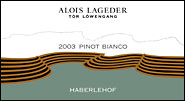I dislike many wines from the 2003 vintage because that hot and dry year in Europe produced overly big wines with dull or baked-fruit aromas and flavors and undeveloped tannins. This Pinot Bianco from Alto Adige, however, reminds me of the dangers in generalizing. While it is a big wine, it is fascinating and delicious.
Alois Lageder is one of the largest private producers in Italy's Alto Adige region--the northerly part of Italy populated by people of Austrian descent, where German is spoken at least as much as Italian is. (About 60 percent of Alto Adige wine is made by co-ops rather than by private producers.) All his wines are very good and very reasonably priced, but the Pinot Bianco from the Haberlehof vineyard has long been one of my favorites.
 About ten years ago, Haberlehof Pinot Bianco was a fairly lean wine with admirable concentration of mineral flavor. It has been taking a richer form in more recent vintages, but typically its crisp acidity is its salient structural element. The 2003 also has high acid, but its full body and viscous texture distract from the acidity and give the wine a richness and roundness that I have never experienced in it before. The acidity, thankfully, prevents the wine from being too rich or too big, however.
About ten years ago, Haberlehof Pinot Bianco was a fairly lean wine with admirable concentration of mineral flavor. It has been taking a richer form in more recent vintages, but typically its crisp acidity is its salient structural element. The 2003 also has high acid, but its full body and viscous texture distract from the acidity and give the wine a richness and roundness that I have never experienced in it before. The acidity, thankfully, prevents the wine from being too rich or too big, however.
For the first time ever in making Haberlehof, Lageder did not put the wine through malolactic fermentation; that accounts for the high acidity despite the wine's obvious ripeness. Most of the juice (90 percent) fermented in stainless steel tanks and aged three months on the lees before being transferred to large Slavonian oak casks for six months. The remaining ten percent of the juice fermented in barrels and spent nine months on the lees. Both the barrel fermentation and the lees aging have apparently help create the wine's rich, almost creamy texture, but the wine contains only the slightest hint of oaky aroma or flavor.
Often a wine's structure interests me more than its aromas and flavors, and that's maybe one of the reasons I like this wine so much. Its aromatics are very low-key. The wine has appley, minerally, earthy and honey notes, but these are not at all intense, especially considering the wine's huge structure. That's appropriate for Pinot Blanc, of course. When you want to make it in an extreme style, I imagine that you can't really take it to another dimension aromatically, because the grape is so limited in its aroma/ flavor potential. So you pump up the texture and structure, as Lageder did here.
Besides its taste, this wine has the virtue of being everyday-affordable. (I questioned the importer: surely $18 must be a mistake?!) Try this wine with grilled swordfish or tuna--the weight of the wine matches the weight of the fish, and the wine's acidity cuts through to refresh your mouth. Roast pork tenderloin or mushroom risotto will also work well--as, I suspect, would oysters.
90 Points